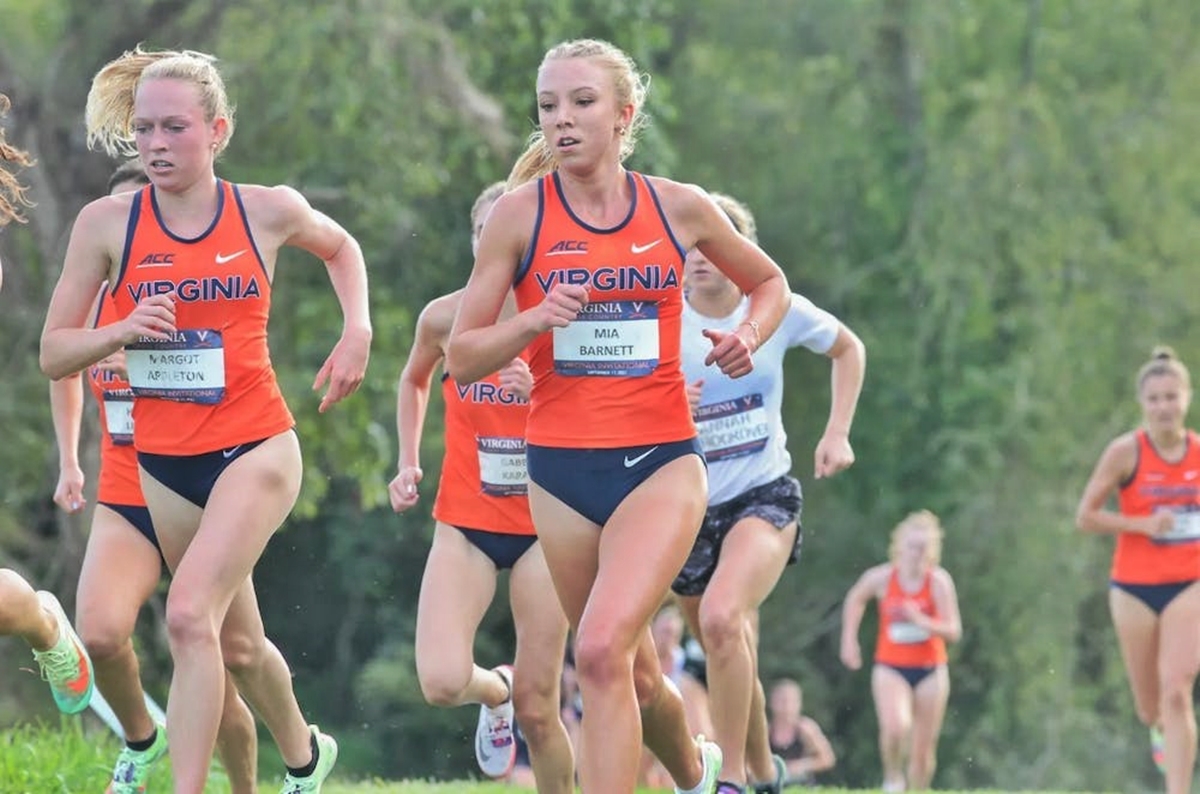

Featured
How Do You Run In Varsity Cross Country
Modified: August 22, 2023
Discover the Featured training techniques and tips for running in varsity cross country. Learn how to optimize your performance and conquer the challenges of competitive running.
Introduction
Cross country running is a challenging sport that requires stamina, mental fortitude, and a deep love for the open terrain. Whether you are a seasoned runner or just starting out, participating in varsity cross country can be an exhilarating experience. It not only pushes your physical limits but also tests your mental resilience. Running through diverse landscapes, conquering steep hills, and sprinting towards the finish line are just some of the adventures that await you in this sport.
Being part of a varsity cross country team means pushing yourself to new heights, both individually and as a team. The sense of camaraderie, the thrill of competition, and the pride of representing your school make the experience all the more rewarding. However, to excel in varsity cross country, you need to be prepared. This article will guide you through the essential aspects of running in varsity cross country, from finding the right shoes to developing endurance and speed, to maintaining proper form, nutrition, injury prevention, cross-training, setting goals, and mental preparation.
Embarking on your varsity cross country journey begins with finding the right pair of running shoes. Proper footwear is crucial to provide comfort, support, and stability while minimizing the risk of injuries. With a vast array of options available, it’s important to consider factors such as fit, cushioning, and arch support when selecting your shoes. Consult with professionals at specialized running stores to ensure you find the perfect pair that suits your unique needs.
Building endurance is a cornerstone of varsity cross country. Training your body to sustain long distances and challenging terrains requires a gradual increase in mileage over time. Incorporating both short, intense runs and longer, slower-paced runs into your training regimen allows your body to adapt to the demands of the sport. Additionally, engaging in interval training and hill workouts will help improve your cardiovascular fitness and strengthen your leg muscles.
Speed is another crucial component of varsity cross country. Developing speed involves incorporating tempo runs, sprints, and interval training into your training routine. By regularly challenging yourself to run at a faster pace, you will increase your overall speed and be better prepared for race day.
Maintaining proper form is essential to optimize your running efficiency and reduce the risk of injuries. Focus on maintaining a relaxed and upright posture, landing midfoot, and maintaining a steady cadence. Engaging in strength and flexibility exercises, such as core workouts and stretching, will also contribute to improving your form and preventing injuries.
Nutrition and hydration play a vital role in your performance as a varsity cross country runner. Fueling your body with a balanced diet rich in carbohydrates, protein, healthy fats, vitamins, and minerals will provide the energy and nutrients needed for optimal performance. Additionally, staying well-hydrated before, during, and after runs will help prevent dehydration and enhance your overall performance.
Injuries can be detrimental to your varsity cross country journey. To minimize the risk of injuries, it’s important to listen to your body, incorporate adequate rest days into your training schedule, and address any discomfort or pain promptly. Proper warm-up and cool-down routines, along with regular stretching and foam rolling, can also help prevent injuries.
Cross training is an effective way to supplement your running and improve your overall fitness. Engaging in activities such as swimming, cycling, and strength training can help build muscle strength, prevent overuse injuries, and enhance your performance on race day.
Setting goals and monitoring your progress are essential for growth and improvement in varsity cross country. By setting realistic and measurable goals, you can stay motivated and track your performance. Keeping a training log, participating in time trials, and seeking feedback from your coach will provide valuable insights into your progress and areas for improvement.
Finally, mental preparation and race strategy are vital components of varsity cross country. Building mental resilience, visualizing success, and developing effective race strategies can give you the edge you need to perform at your best when it matters most. Embrace the challenges, stay focused, and trust in your training.
The journey of running in varsity cross country is an exhilarating one. It requires dedication, perseverance, and a relentless passion for the sport. By focusing on essential aspects such as finding the right shoes, building endurance and speed, maintaining proper form, nutrition, injury prevention, cross-training, setting goals, and mental preparation, you can elevate your performance and unleash your full potential in varsity cross country.
Finding the Right Shoes
When it comes to participating in varsity cross country, finding the right pair of running shoes is crucial. The right footwear not only provides comfort but also plays a significant role in preventing injuries and enhancing your performance. With so many options available, it can be overwhelming to choose the perfect pair. However, considering a few key factors will help you make an informed decision.
The first step in finding the right shoes is to understand your foot type. There are three main foot types: neutral, high arches, and flat feet. Knowing your foot type will help you determine the level of arch support and cushioning you need. If you’re unsure about your foot type, you can visit a specialized running store where experts can analyze your gait and advise you on the most suitable shoes.
Next, consider the fit of the shoes. The shoes should fit snugly but not be too tight. You should have enough room in the toe box to wiggle your toes comfortably. Keep in mind that your feet may swell during long runs, so it’s a good idea to try on shoes at the end of the day when your feet are slightly larger. Taking the time to try on different brands and models will ensure you find the perfect fit for your feet.
Another important factor to consider is cushioning. The cushioning in running shoes helps absorb shock and reduce the impact on your joints as you run. Depending on the terrain you’ll be running on, you may want more cushioning for added comfort and protection. However, keep in mind that too much cushioning can affect your stability and proprioception, so find the right balance that suits your needs.
One aspect that is often overlooked is the weight of the shoes. Lighter shoes can provide a more responsive and faster running experience, especially on flat terrains. However, if you’ll be running on rugged trails or uneven surfaces, you may prefer shoes with a bit more weight and stability to provide better traction and support.
Another consideration is the durability of the shoes. Cross country running can be tough on footwear, with rocky trails, muddy courses, and various weather conditions. Look for shoes with durable outsoles, reinforced toe caps, and sturdy materials that can withstand the demands of cross country running. It’s also a good idea to read reviews or talk to experienced runners for insights into the durability of different shoe models.
Finally, don’t forget to factor in your budget. Running shoes come in a wide range of price points, so determine your budget beforehand and shop accordingly. While more expensive shoes may offer advanced technologies and premium materials, there are also quality options at more affordable prices.
Remember, finding the right pair of shoes is a personal journey. What works for someone else may not necessarily work for you. Take the time to try on different brands, models, and sizes. Pay attention to how the shoes feel when you run or walk around in them. Trust your instincts and select the shoes that provide the best combination of comfort, support, and performance for your feet and running style.
Building Endurance
Endurance is a crucial component of varsity cross country. Building your endurance will enable you to run longer distances, tackle challenging terrains, and maintain your pace throughout a race. Here are some effective strategies to help you build your endurance and improve your performance in varsity cross country.
Gradual Progression: Building endurance requires a gradual progression in your training. Start by running at a comfortable pace for shorter distances and gradually increase the mileage each week. Aim to add around 10% to your total weekly mileage to prevent overtraining and reduce the risk of injury. This gradual increase allows your body to adapt to the new demands and build endurance over time.
Vary Your Runs: Incorporate a mix of longer, slower-paced runs and shorter, more intense runs into your training routine. Long runs help build aerobic endurance and prepare your body for the demands of cross country. During these runs, focus on maintaining a conversational pace and gradually extending the distance. Shorter, faster runs such as tempo runs or interval training help improve your lactate threshold and increase your overall speed. Alternating between these types of runs will help you build both endurance and speed.
Hill Training: Cross country courses often feature challenging hills, so incorporating hill training into your routine is essential. Hill running strengthens your leg muscles, improves cardiovascular fitness, and enhances your overall endurance. Find a hill with a moderate incline and run repeats up the hill, focusing on maintaining good form and using your arms for additional power. As you progress, you can increase the number of hill repeats or find steeper hills for added difficulty.
Interval Training: Interval training involves alternating between high-intensity bursts of running and periods of recovery. This type of training helps improve your oxygen uptake and running economy, leading to increased endurance. Choose a distance or time interval, such as 400 meters or one minute, and run at a faster pace than your usual race pace. Follow it with a short recovery period, jogging or walking. Repeat this cycle for several intervals. As you get fitter, you can increase the number and intensity of intervals.
Consistency and Rest: Consistency is key when it comes to building endurance. Aim for regular training sessions throughout the week to maintain progress. However, it’s important to give your body adequate rest and recovery time. Rest days allow your muscles to repair and rebuild, reducing the risk of overuse injuries. Listen to your body and adjust your training schedule accordingly to ensure a balance between training and rest.
Proper Nutrition and Hydration: To build endurance, you need to fuel your body with the right nutrients. Ensure you have a well-balanced diet consisting of carbohydrates, proteins, healthy fats, and vitamins and minerals. Carbohydrates provide the primary source of energy for endurance running, so include foods such as whole grains, fruits, and vegetables. Hydration is also critical for optimal performance. Drink enough water throughout the day and especially before, during, and after your runs to stay hydrated.
Cross-training: In addition to running, incorporating cross-training activities into your routine can help improve endurance. Activities such as swimming, cycling, or using an elliptical machine engage different muscle groups and provide aerobic conditioning without the impact of running. Engaging in cross-training activities can give your running muscles a break while still maintaining your cardiovascular fitness.
Building your endurance in varsity cross country is a gradual process that requires consistency, dedication, and patience. By incorporating these strategies into your training routine, you will gradually improve your endurance, tackle challenging terrains with ease, and achieve your goals on race day.
Developing Speed
A key aspect of varsity cross country is developing speed. To excel in races, you need to have the ability to maintain a fast pace and accelerate when necessary. Here are some effective strategies to help you develop your speed and improve your performance in varsity cross country.
Interval Training: Interval training is a crucial component of speed development. By running at a faster pace for shorter distances with periods of recovery in between, you can improve your aerobic and anaerobic capacity, as well as your running economy. Incorporate interval training sessions into your training routine, focusing on running at a pace faster than your goal race pace. For example, run 400-meter or 800-meter repeats at a challenging pace, followed by a recovery jog or walk. Gradually increase the number of intervals and the intensity as you progress.
Tempo Runs: Tempo runs are runs performed at a comfortably hard pace, just below your maximum effort. These runs improve your lactate threshold, allowing you to sustain a faster pace for a longer period. Start with a 10-15 minute warm-up, then maintain your tempo pace for a designated distance or time. It’s important to maintain good form and focus on breathing rhythmically and evenly throughout the run. Incorporate tempo runs into your training schedule once or twice a week to improve your speed and endurance.
Sprints: Sprinting is an effective way to develop your muscle power and improve your speed. Incorporate short, all-out sprints into your training sessions. Find a flat stretch of road or track and sprint for 50-100 meters, focusing on pumping your arms and driving your knees. Allow for adequate recovery time between sprints to maintain the quality of each effort. Sprint training not only improves your speed but also helps with your running form and explosiveness.
Strength Training: Building overall strength is important for speed development. Incorporate strength training exercises into your routine, focusing on developing leg strength, core stability, and upper body strength. Incorporate exercises such as squats, lunges, calf raises, planks, and push-ups into your workouts. Strengthening your muscles will improve your power output, enhance your running economy, and help you maintain a strong and efficient form throughout races.
Fartlek Runs: Fartlek, which means “speed play” in Swedish, is a training technique that involves alternating between fast and slow segments during a run. Incorporate fartlek runs into your training routine, where you randomly incorporate periods of faster running or sprints for a certain distance or time. Use landmarks or a timer to guide your sprinting and recovery periods. Fartlek runs not only improve your speed but also add an element of spontaneity and excitement to your training.
Proper Warm-up and Cool-down: A proper warm-up and cool-down routine are essential for speed development and injury prevention. Before your speed workouts, engage in dynamic stretching exercises that target your running muscles. This helps prepare your muscles for the intense efforts ahead. After your speed workouts, cool down with a slower-paced jog or walk and perform static stretches to aid in muscle recovery and flexibility.
Mental Preparation: Speed is not just about physical capabilities but also about mental fortitude. Developing mental toughness is crucial to maintain a fast pace and push through any discomfort during races. Incorporate mental preparation techniques such as visualization, positive self-talk, and goal-setting into your training routine. Build confidence in your speed through mental rehearsals of successful runs and envisioning yourself achieving your goals.
Remember that developing speed takes time and consistent effort. Patience and perseverance are key as you gradually increase your pace and push your limits. By incorporating interval training, tempo runs, sprints, strength training, fartlek runs, proper warm-up and cool-down routines, and mental preparation into your training routine, you will develop the speed necessary to excel in varsity cross country.
Maintaining Proper Form
Maintaining proper form is essential to optimize your running efficiency, prevent injuries, and improve your overall performance in varsity cross country. Proper form allows you to run more efficiently, conserve energy, and maintain a steady pace throughout races. Here are some key elements to focus on to ensure you maintain proper form.
Posture: Maintaining good posture is crucial for efficient running. Keep your head up, looking straight ahead, not down at your feet. Your shoulders should be relaxed and level, not hunched or tense. Engage your core muscles to maintain stability and prevent excessive movements. Avoid slouching or leaning forward, as it can disrupt your balance and impede your forward momentum.
Footstrike: Pay attention to how your feet land on the ground. Aim for a midfoot strike, where your foot makes contact with the ground just below the ball of your foot. Avoid striking with your heel first, as it can lead to inefficient and jarring movements. A midfoot strike helps in better shock absorption and propulsion during each stride.
Cadence: Your cadence refers to the number of steps you take per minute. Aim for a cadence of around 180 steps per minute, which is considered optimal for most runners. Increasing your cadence can help improve your running efficiency and reduce the risk of overstriding. Focus on taking quick and light steps, as this promotes a more efficient and smoother stride.
Arm Position: Your arms play a crucial role in maintaining balance and providing propulsion. Bend your arms at a 90-degree angle and swing them naturally back and forth, avoiding any excessive movements that may waste energy. Keep your hands relaxed and avoid clenching your fists. The arm swing should be forward and backward, not across your body, to maintain a straight and efficient forward motion.
Breathing: Proper breathing technique is essential for maintaining your endurance and running efficiency. Breathe deeply and rhythmically, inhaling through your nose and exhaling through your mouth. Focus on expanding your diaphragm and fully exhaling to help expel carbon dioxide. Find a breathing pattern that works for you, such as a 2:2 (inhale for two steps, exhale for two steps) or a 3:2 (inhale for three steps, exhale for two steps), and adjust it according to your pace and effort level.
Flexibility and Strength: In addition to focusing on your running form, it’s important to work on your flexibility and strength. Engage in regular stretching exercises to maintain a good range of motion in your joints and prevent muscle imbalances. Strengthen your core muscles, hips, and glutes through targeted exercises to provide stability and support during your runs. These additional elements contribute to maintaining proper form and reducing the risk of injuries.
Video Analysis: Consider recording your runs and analyzing your form through video analysis. This can help you identify areas for improvement and make necessary adjustments. Seek feedback from coaches, trainers, or experienced runners who can provide insights and tips to enhance your form.
Practice and Conscious Awareness: Developing and maintaining proper form requires practice and conscious awareness. During your training runs, focus on your posture, footstrike, cadence, and arm position. Regularly check in with your body and make adjustments if you feel any discomfort or inefficiency. Over time, proper form will become more natural and automatic.
By maintaining proper form in varsity cross country, you can optimize your running efficiency, reduce the risk of injuries, and improve your overall performance. Focus on your posture, footstrike, cadence, arm position, breathing technique, and work on flexibility and strength. With practice and conscious awareness, proper form will become second nature, helping you maximize your potential as a cross country runner.
Nutrition and Hydration
Nutrition and hydration play a vital role in your performance as a varsity cross country runner. Proper fueling before, during, and after workouts and races can enhance your energy levels, improve your endurance, and aid in your recovery. Here are some key considerations to keep in mind regarding nutrition and hydration as a varsity cross country runner.
Pre-Run Fueling: It’s important to fuel your body with the right nutrients before your runs. Consume a balanced meal or snack containing carbohydrates, protein, healthy fats, and fiber. Carbohydrates provide the primary source of energy for running, so include foods such as whole grains, fruits, vegetables, and legumes. Protein helps repair and rebuild muscles, so incorporate lean sources such as chicken, fish, tofu, or beans. Healthy fats, such as avocados or nuts, provide sustained energy and aid in nutrient absorption. Avoid heavy or greasy meals before running, as they may cause digestive discomfort.
Hydration: Proper hydration is essential for optimal performance. Adequate fluid intake before, during, and after runs helps maintain blood volume, regulate body temperature, and support overall physiological function. Drink water regularly throughout the day and aim to consume about 16-20 ounces of water 2-3 hours before your run. During your runs, sip on water or electrolyte-rich sports drinks to replenish fluids and electrolytes lost through sweating. After your runs, continue hydrating to aid in recovery.
During-Run Fueling: For longer runs or races lasting over 60 minutes, consider fueling with easily digestible carbohydrates to maintain your energy levels. Options include energy gels, sports drinks, or small snacks like energy bars or bananas. Experiment and find what works best for you during training runs to avoid any digestive issues on race day. Consume small amounts at regular intervals to avoid feeling overly full or bloated.
Post-Run Recovery: After your runs, prioritize recovery and replenishment. Consume a balanced post-run meal or snack within 30-60 minutes to replenish glycogen stores and aid in muscle recovery. Aim for a combination of carbohydrates and protein, such as a fruit smoothie with Greek yogurt, or a turkey and vegetable wrap. Including a source of lean protein helps rebuild damaged muscle tissue, while carbohydrates restore glycogen levels. Additionally, stay hydrated by continuing to drink water throughout the day.
Healthy Eating Habits: Aside from pre and post-run nutrition, prioritize a well-balanced diet in your day-to-day life as a varsity cross country runner. Consume a variety of fruits, vegetables, whole grains, lean proteins, and healthy fats. Aim for balanced meals that provide a mix of macronutrients and essential vitamins and minerals. Incorporate sources of iron, such as lean meats, spinach, or lentils, to support red blood cell production and prevent anemia. Fueling your body with nutrient-dense foods will provide the energy and nutrients needed for optimal performance.
Individual Needs: Keep in mind that nutrition and hydration needs vary from person to person. Experiment with different foods and fluid intake during training to identify what works best for you. Consider consulting with a sports nutritionist who can provide personalized recommendations based on your training schedule, body composition, and individual goals. They can guide you on proper portion sizes, nutrient timing, and specific dietary needs to optimize your performance.
Listen to Your Body: Pay attention to how your body responds to different foods and fluids. If certain foods or drinks cause discomfort or digestive issues, make note of them and avoid them before or during runs. Eat intuitively, honoring your hunger and fullness cues, and adjust your nutrition plan accordingly.
Remember, proper nutrition and hydration are key to fueling your body and optimizing your performance as a varsity cross country runner. Prioritize a well-balanced diet, stay hydrated, and listen to your body’s unique needs. By nourishing yourself effectively, you can perform at your best and recover efficiently, allowing you to push your limits in varsity cross country.
Injury Prevention
Injury prevention is crucial for maintaining your performance and longevity as a varsity cross country runner. The repetitive nature of running and the demands of cross country can put stress on your muscles, joints, and connective tissues. By following proper injury prevention strategies, you can reduce the risk of common running injuries and stay on track with your training. Here are some key strategies to help prevent injuries.
Gradual Progression: One of the most crucial aspects of injury prevention is following a gradual progression in your training. Gradually increase your mileage, pace, or intensity to allow your body to adapt and become stronger. Avoid sudden spikes in training volume or intensity, as this can overload your muscles and increase the risk of injury. Listen to your body and be mindful of any signs of fatigue or excessive soreness.
Proper Warm-up: Always start your runs with a proper warm-up routine. Begin with some light aerobic exercises such as jogging or brisk walking to increase blood flow to your muscles. Then, incorporate dynamic stretches that mimic the movements you’ll be performing during your run. Dynamic stretching helps warm up your muscles, increase their flexibility, and improve joint range of motion.
Strength Training: Incorporating strength training exercises into your routine can help prevent injuries by strengthening muscles and supporting your joints. Focus on exercises that target your lower body, such as squats, lunges, calf raises, and hip strengthening exercises. Additionally, include exercises that work your core and upper body, as overall strength is important for maintaining proper form and stability.
Flexibility and Mobility: Maintaining flexibility and mobility is essential for injury prevention. Incorporate regular stretching into your routine, focusing on muscles that tend to be tight in runners, such as the hip flexors, hamstrings, calves, and IT band. Consider incorporating activities like yoga or Pilates to improve overall flexibility and joint mobility.
Proper Footwear: Wearing appropriate running shoes is vital for injury prevention. Make sure your shoes provide adequate support, cushioning, and stability. Replace your shoes regularly, as worn-out shoes can lead to imbalances and increased stress on your joints. Consider visiting a specialized running store to get properly fitted for shoes that suit your foot type and running style.
Cross Training: Engaging in cross training activities can help reduce the risk of overuse injuries and provide a break from the repetitive stresses of running. Activities such as swimming, cycling, or using an elliptical machine provide a low-impact workout while still improving your cardiovascular fitness. Incorporate cross training into your training schedule to give your running muscles a break and maintain overall fitness.
Rest and Recovery: Rest days are just as important as training days. Make sure to incorporate rest days into your training schedule to allow your body to recover and repair. Listen to your body and identify any signs of overtraining or excessive fatigue. If you experience persistent pain or discomfort, seek medical attention and allow yourself adequate time to recover before returning to training.
Proper Nutrition: Proper nutrition plays a vital role in injury prevention. A well-balanced diet that includes a variety of nutrient-dense foods can support muscle recovery and tissue repair. Ensure you are consuming enough calories, macronutrients, and micronutrients to fuel your training and promote optimal recovery. Consult with a sports nutritionist to tailor your nutrition plan to your individual needs.
Listen to Your Body: Above all, listen to your body and honor its signals. Pay attention to any unusual pain, discomfort, or persistent soreness. Responding promptly to these warning signs can help prevent minor issues from turning into more serious injuries. If you have concerns or doubts, consult with a healthcare professional or a sports medicine specialist.
Preventing injuries is essential for maintaining consistent training and reaching your full potential as a varsity cross country runner. By following these injury prevention strategies, you can reduce the risk of common running injuries and enjoy a long and successful running career.
Cross Training
Cross training, or incorporating activities other than running into your training routine, is an effective strategy for enhancing your performance in varsity cross country. By engaging in various forms of exercise, you can improve your overall fitness, prevent overuse injuries, and even enhance your running performance. Here are some key benefits and ways to incorporate cross training into your training regimen.
Benefits of Cross Training:
- Injury Prevention: By engaging in activities that are different from running, you can reduce the risk of overuse injuries. Running puts repetitive stress on your muscles and joints, so cross training allows for recovery and strengthens other muscle groups.
- Improved Fitness: Cross training helps improve overall fitness by targeting different muscle groups and energy systems. It can enhance cardiovascular endurance, muscular strength, and flexibility.
- Mental Refreshment: Cross training can provide a mental break from continuous running. Engaging in different activities can revive your motivation and prevent burnout.
- Enhanced Performance: Cross training can complement your running by improving areas such as strength, power, agility, and balance. These elements can positively impact your running form and efficiency.
Ways to Incorporate Cross Training:
- Swimming: Swimming is a low-impact activity that provides a great cardiovascular workout while engaging all major muscle groups. It helps improve your lung capacity, endurance, and overall body strength.
- Cycling: Cycling is a non-weight bearing activity that can boost your cardiovascular fitness and leg strength. Whether indoor on a stationary bike or outdoors on roads or trails, cycling provides an excellent low-impact cardio option.
- Strength Training: Incorporating strength training exercises into your routine is crucial for improving muscle strength, power, and stability. Focus on exercises that target your lower body, core, and upper body to improve overall strength and balance.
- Pilates and Yoga: Pilates and yoga can improve flexibility, core strength, and stability. These practices also promote body awareness, mindfulness, and relaxation, which can benefit your running form and mental focus.
- Elliptical Machine: Using an elliptical machine provides a low-impact, full-body workout that mimics the running motion. It can help improve cardiovascular fitness while reducing strain on your joints.
- HIIT Workouts: High-Intensity Interval Training (HIIT) workouts involve short bursts of intense exercise followed by periods of rest or lower-intensity exercise. HIIT workouts can improve cardiovascular fitness, speed, power, and metabolic efficiency.
Integrating cross training into your training routine requires careful planning and consideration of the specific needs of your running program. Here are some tips to incorporate cross training effectively:
- Schedule: Plan your cross training sessions strategically. Consider alternating cross training days with running days or incorporating cross training on your recovery days.
- Balance: Ensure that your cross training activities complement your running goals. Focus on activities that address your weaknesses and support your overall fitness and performance.
- Progression: Gradually increase the intensity and duration of your cross training activities over time. This will help you avoid overexertion and improve your fitness levels.
- Listen to your body: Pay attention to how your body responds to cross training activities. If you feel excessive fatigue or discomfort, adjust the intensity or duration accordingly. Rest and recovery are just as important for cross training as they are for running.
- Stay consistent: Incorporate cross training regularly into your routine for maximum benefit. Consistency is key for reaping the rewards of cross training.
Cross training can be a valuable addition to your varsity cross country training program. By incorporating activities like swimming, cycling, strength training, and more, you can improve overall fitness, prevent injuries, and enhance your running performance. Experiment with different activities, find what you enjoy, and tailor your cross training plan to meet your specific needs and goals.
Setting Goals and Monitoring Progress
Setting goals and monitoring your progress are essential components of a successful varsity cross country season. Goals provide direction, motivation, and a sense of purpose, while monitoring your progress allows you to track your development and make necessary adjustments to your training. Here are some key strategies for setting goals and effectively monitoring your progress in varsity cross country.
Setting Goals:
- Long-term Goals: Start by setting long-term goals that encompass your overall aspirations for the season. These goals can include achieving a specific race time, making it to regionals or state championships, or improving your overall ranking. Long-term goals provide a clear vision and serve as a guiding force throughout the season.
- Short-term Goals: Break down your long-term goals into smaller, more manageable short-term goals. These goals should be specific, measurable, attainable, relevant, and time-bound (SMART). Examples include improving your mile time by a certain percentage, increasing your weekly mileage gradually, or consistently finishing in the top three in team practice runs.
- Process Goals: In addition to outcome-based goals, focus on process goals that are centered around improving your training habits and skills. Process goals can include incorporating specific strength exercises into your routine, improving your form, or consistently practicing mental preparation techniques.
Monitoring Progress:
- Training Log: Keep a training log where you record details of your workouts, including distance, time, pace, and any notable observations or challenges. A training log helps you track your progress, identify patterns or trends, and evaluate the effectiveness of your training plan.
- Time Trials: Organize periodic time trials or mock races to gauge your performance and assess your progress. These self-paced races can serve as benchmarks to compare your current performance to previous time trials or races. Analyze your results, note areas for improvement, and adjust your training accordingly.
- GPS Watches and Running Apps: Utilize GPS watches or running apps to track your runs and monitor your pace, distance, and elevation. These tools can provide valuable data to track your progress and give you insights into your performance over time.
- Coach and Peer Feedback: Seek feedback from your coach, teammates, and peers. They can provide valuable perspective and insights on your strengths and areas for improvement. Consider participating in regular team meetings or individual discussions with your coach to discuss your progress and set new goals.
Adjusting Goals and Plans:
- Assess and Reflect: Regularly assess your progress and reflect on your achievements, challenges, and areas for improvement. Acknowledge your successes and celebrate your accomplishments, but also identify areas where you may have fallen short or encountered difficulties.
- Adapt and Modify: Based on your assessments, make adjustments to your training plan, goals, or strategies as needed. If you are consistently falling short of your performance targets, consider seeking guidance from your coach or a sports specialist to help you adjust your training plan or address any weaknesses.
- Stay Motivated: Consistently remind yourself of your goals and the reasons why you pursued varsity cross country. Find ways to stay motivated, whether it’s visualizing success, finding a training partner, or participating in team activities. Keep a positive mindset and embrace the process of growth and improvement.
Remember, setting goals and monitoring your progress are ongoing processes throughout the varsity cross country season. By setting SMART goals, tracking your progress through training logs, time trials, technology, and feedback, and adapting your goals and plans as needed, you can stay on track and continually strive for improvement to reach your full potential as a varsity cross country runner.
Mental Preparation and Race Strategy
Mental preparation and race strategy are crucial elements for success in varsity cross country. Developing mental resilience, focusing your mindset, and strategizing your race can give you the edge you need to perform at your best when it matters most. Here are some strategies to help you mentally prepare and strategize for your races in varsity cross country.
Mental Preparation:
- Visualize Success: Use the power of visualization to imagine yourself succeeding in your races. Create detailed mental images of yourself running strong, maintaining a steady pace, and finishing the race with confidence. Visualizing success can help boost your confidence and enhance your performance on race day.
- Positive Self-Talk: Adopt a positive and empowering inner dialogue. Replace negative thoughts or doubts with positive affirmations and self-encouragement. Use phrases such as “I am strong,” “I am capable,” and “I can overcome any challenge.” Positive self-talk can foster a resilient mindset and help you stay focused during races.
- Establish Race Day Rituals: Create a set of pre-race rituals or routines that help you mentally prepare. This can include listening to specific music, performing a warm-up routine, or engaging in calming breathing exercises. Consistency in rituals can provide a sense of familiarity and help you enter a focused state of mind.
- Break the Race into Segments: Mentally break the race into smaller segments or checkpoints. Focus on completing each segment before moving onto the next. Breaking the race into smaller goals can make it feel more manageable and maintain your focus throughout the race.
Race Strategy:
- Know the Course: Familiarize yourself with the race course. If possible, run or walk the course beforehand to understand the terrain, elevation changes, and any challenging sections. Knowing the course will allow you to strategize your approach and anticipate key points during the race.
- Start Strong, Pace Wisely: Begin the race with confidence and determination. Find a pace that is challenging yet sustainable for the entire duration. Avoid going out too fast and burning out early. Pacing yourself strategically will help you maintain your energy and avoid hitting the wall later in the race.
- Stay Mentally Engaged: Stay present and focused throughout the race. Avoid getting distracted or losing concentration. Keep your mind engaged by focusing on your breathing, maintaining proper form, and staying aware of your surroundings.
- Adapt to Race Conditions: Be prepared to adjust your race strategy based on the conditions on race day. Weather, course conditions, and competition can all impact your plan. Stay flexible and be ready to make quick decisions to maximize your performance.
Finish Strong:
- Finish with a Kick: As you approach the finish line, give it your all and finish with a strong kick. Dig deep and tap into your reserves of energy to sprint to the finish line. This display of determination can boost your confidence and leave a positive lasting impression.
- Reflect and Learn: After the race, take some time to reflect on your performance. Identify areas where you excelled and celebrate your accomplishments. Also, acknowledge areas that can be improved and look for lessons and opportunities for growth. Use this reflection as fuel for future races and training.
- Set New Goals: Once you have evaluated your race performance, set new goals for yourself. Whether it’s improving your time, technique, or overall ranking, setting new goals will keep you motivated and drive your continued growth as a varsity cross country runner.
Racing in varsity cross country requires not only physical preparation but also mental strength and strategic thinking. By incorporating mental preparation techniques, developing a race strategy, and staying adaptable and focused, you can optimize your performance and achieve your desired results in varsity cross country.
Conclusion
Participating in varsity cross country is an exhilarating journey that tests your physical endurance, mental resilience, and commitment to the sport. By focusing on essential aspects such as finding the right shoes, building endurance and speed, maintaining proper form, nutrition, injury prevention, cross-training, setting goals, and mental preparation, you can elevate your performance and make the most of your varsity cross country experience.
Finding the right pair of running shoes is crucial for comfort, support, and injury prevention. Building endurance through gradual progression, varied runs, hill training, and interval training helps you conquer long distances and challenging terrains. Developing speed through interval training, tempo runs, and sprints enhances your ability to maintain a fast pace. Maintaining proper form optimizes your running efficiency and reduces the risk of injuries.
Effective nutrition and hydration strategies fuel your body for optimal performance. Prioritizing a well-balanced diet, staying hydrated, and listening to your body’s needs are key elements. Implementing injury prevention techniques such as proper warm-up, strength training, flexibility, and rest can help you avoid pitfalls and maintain consistency in your training.
Embracing cross training activities allows you to improve overall fitness, prevent overuse injuries, and complement your running performance. Setting SMART goals and monitoring your progress through training logs, time trials, technology, and feedback provide valuable insights and aid in continuous improvement.
Mental preparation and race strategy are essential components of varsity cross country success. Developing mental resilience, visualizing success, establishing race day rituals, and strategizing your race allows for focused and confident performances.
As you embark on your varsity cross country journey, keep pushing yourself, embracing challenges, and setting ambitious goals. Celebrate your successes, learn from setbacks, and stay motivated throughout the season. Remember, varsity cross country is not solely about the destination but the exhilarating experiences and personal growth you encounter along the way.








